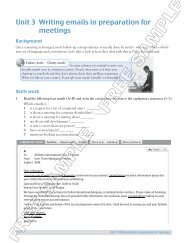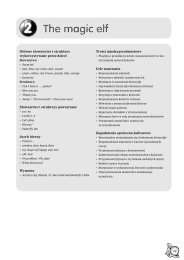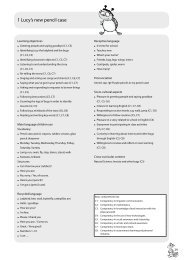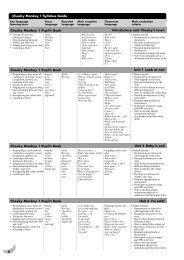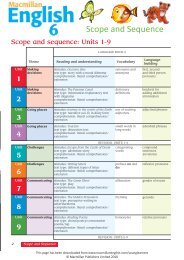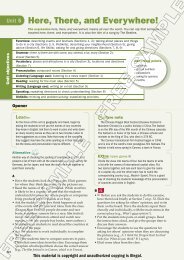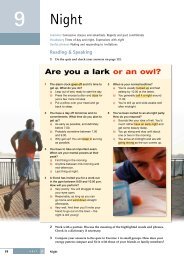Pobierz - Macmillan
Pobierz - Macmillan
Pobierz - Macmillan
Create successful ePaper yourself
Turn your PDF publications into a flip-book with our unique Google optimized e-Paper software.
78<br />
6 ŻYWIENIE<br />
2<br />
Zadanie 1<br />
Zadanie 2<br />
Rozgrzewka<br />
SŁOWNICTWO<br />
Poniższe słowa brzmią lub wyglądają podobnie w języku polskim i angielskim. Sprawdź ich znaczenie.<br />
Posłuchaj i zaznacz (3) te wyrazy, których polska wymowa najbardziej różni się od angielskiej.<br />
banana<br />
chocolate<br />
cream<br />
jam<br />
pizza<br />
pasta<br />
Skreśl słowa, które nie pasują do danej kategorii. Dopisz je do odpowiedniej grupy. W każdej kategorii może być więcej<br />
niż jedno niepasujące słowo.<br />
Fruit: apple – banana – cucumber – cream – orange – tomato – bread ______________________________________________________<br />
Vegetables: carrot – ice cream – potato – cabbage – peas – onion _ ________________________________________________________<br />
Dairy products: butter – eggs – cheese – strawberry – yoghurt ____________________________________________________________<br />
Meat: beef – chicken – milk – lamb – bacon – pear – cornflakes ___________________________________________________________<br />
Drinks: tea – coffee – cake – pork – steak – water – sausage ______________________________________________________________<br />
Snacks: biscuits – chocolate – ham – turkey – pasta – crisps ______________________________________________________________<br />
Other types of food: nuts – jam – rice – mushrooms – fish – lemonade ______________________________________________________<br />
Odpowiedz na pytania. Użyj wyrazów z ramki.<br />
ŻYWIENIE >>> SŁOWNICTWO<br />
spaghetti<br />
steak<br />
yoghurt<br />
sugar salt pepper chilli peppers honey curry<br />
What makes food ...<br />
salty<br />
sweet<br />
spicy<br />
salad<br />
soup<br />
dessert<br />
fast food<br />
lunch<br />
grill<br />
mix<br />
café<br />
bar<br />
menu<br />
Uzupełnij brakujące litery w nazwach produktów spożywczych i wpisz te nazwy do odpowiedniej kolumny tabeli.<br />
b sc it<br />
ca e<br />
chi s<br />
s a lt y<br />
c oc l te<br />
ho sera i h<br />
c i ps<br />
h r ing<br />
m s ard<br />
pea u s<br />
s w e e t<br />
p ne p le<br />
c ll s uc<br />
pu di g<br />
s la i<br />
sa d nes<br />
FREE SAMPLE FREE SAMPLE<br />
s p i c y
2<br />
Zadanie 3<br />
Zadanie 5<br />
Zadanie 6<br />
SŁOWNICTWO<br />
Znajdź w wężu wyrazowym odpowiednie słowa, aby uzupełnić poniższe wyrażenia.<br />
1 _______________ products<br />
2 _______________ pie<br />
3 _______________ chicken<br />
Zadanie 4<br />
a. For lunch I had tomato soup and a mixed salad.<br />
b. For the main course I had grilled chicken<br />
and some boiled vegetables.<br />
c. For dinner I went to a restaurant.<br />
d. I had no dessert after the meal.<br />
e. For supper at home I just had a piece of toast with butter<br />
and a cup of tea.<br />
f. For a starter I had a piece of melon.<br />
orangeappledairyfastroastmixedmineralfizzypacked<br />
g. For breakfast I had a bowl of cornflakes and a glass of water.<br />
Na podstawie zadania 4. napisz wypowiedź osoby, która niezdrowo się odżywia. Na każdy posiłek wymyśl inne dania / produkty.<br />
________________________________________________________________________________________________________________<br />
________________________________________________________________________________________________________________<br />
________________________________________________________________________________________________________________<br />
________________________________________________________________________________________________________________<br />
________________________________________________________________________________________________________________<br />
________________________________________________________________________________________________________________<br />
________________________________________________________________________________________________________________<br />
________________________________________________________________________________________________________________<br />
________________________________________________________________________________________________________________<br />
________________________________________________________________________________________________________________<br />
Uzupełnij zdania informacjami o sobie. W luki należy wpisać nazwy potraw lub produktów spożywczych.<br />
1. I usually have _________________________ for breakfast.<br />
2. My favourite snack is / are _________________________ .<br />
3. I usually have _________________________ for dinner.<br />
4. My favourite type of foreign food is _________________________ .<br />
5. I don’t like eating _________________________ .<br />
4 _______________ salad<br />
5 _______________ water<br />
6 _______________ juice<br />
1 2 3 4 5 6 7<br />
6. I couldn’t live without _________________________ .<br />
7 _______________ lunch<br />
8 _______________ drink<br />
9 _______________ food<br />
Ułóż zdania a-g w takiej kolejności, aby powstała logiczna i spójna wypowiedź Mariko.<br />
Następnie wysłuchaj nagrania, aby sprawdzić odpowiedź.<br />
ŻYWIENIE<br />
FREE SAMPLE FREE SAMPLE<br />
ŻYWIENIE >>> SŁOWNICTWO<br />
6<br />
79
80<br />
6 ŻYWIENIE<br />
Zadanie 7<br />
Znajdź w diagramie nazwy przedmiotów przedstawionych na rysunkach.<br />
p l a t e<br />
a c f o g<br />
s p o o n<br />
k o r d k<br />
n t k g e<br />
i t h l t<br />
f z x a t<br />
e m u s l<br />
c u p s e<br />
b g j g p<br />
Zadanie 8<br />
Zadanie 9<br />
Zadanie 10<br />
Zadanie 11<br />
ŻYWIENIE >>> SŁOWNICTWO<br />
SŁOWNICTWO<br />
Do podanych czasowników dopasuj rzeczowniki z ramki, tak aby utworzyć poprawne zwroty. W niektórych przypadkach<br />
więcej niż jedna odpowiedź jest prawidłowa.<br />
a sandwich bread a cake water a meal meat ingredients eggs wegetables chips spices a pancake<br />
make _ ________________________________________________<br />
bake __________________________________________________<br />
boil_ __________________________________________________<br />
Odpowiedz na poniższe pytania. Na trzy z nich można udzielić tej samej odpowiedzi.<br />
fry ___________________________________________________<br />
mix __________________________________________________<br />
cut ___________________________________________________<br />
1. What can you order in a pub _____________________________________________________________________________________<br />
2. Who do you give a tip to _ _______________________________________________________________________________________<br />
3. What can you buy in a typical school canteen _______________________________________________________________________<br />
4. Who serves you in a restaurant ___________________________________________________________________________________<br />
5. What can you eat in a coffee shop ________________________________________________________________________________<br />
6. Where can you find a list of meals on offer in a restaurant _ ____________________________________________________________<br />
7. What can you buy as a take-away _________________________________________________________________________________<br />
8. Who gives you the bill in a restaurant ______________________________________________________________________________<br />
Dodaj literę lub litery do podanych wyrazów, aby utworzyć słowa związane z tematem ŻYWIENIE. Podaj kilka podobnych<br />
przykładów i przetestuj kolegę / koleżankę.<br />
1. _______tables<br />
2. _______read<br />
3. _______eat<br />
4. _______teen<br />
5. _______oil<br />
6. _______ill<br />
7. _______hurt<br />
8. _______late<br />
9. _______key<br />
10. _______ear<br />
11. _______rooms<br />
12. _______ink<br />
Sprawdź swoją pamięć. Bez zaglądania do książki sporządź listę jak największej liczby wyrazów związanych z tematem<br />
ŻYWIENIE zaczynających się od samogłoski.<br />
FREE SAMPLE FREE SAMPLE
Ania:<br />
Peter:<br />
Ania:<br />
Peter:<br />
Ania:<br />
Peter:<br />
Ania:<br />
Peter:<br />
Ania:<br />
Peter:<br />
Ania:<br />
Peter:<br />
Ania:<br />
Peter:<br />
Zadanie 2<br />
Zadanie 3<br />
Zadanie 4<br />
Zadanie 1<br />
przydatne ZWROTY<br />
Przeczytaj dialog i zdecyduj, które z wyróżnionych wyrazów / wyrażeń są poprawne. W niektórych zdaniach obie<br />
odpowiedzi są właściwe.<br />
So what 1. shall / will I have 2. I’ve never tried / I never tried some of these dishes in my life.<br />
That’s why I’ve brought you here. It’s a traditional English pub which serves traditional English food. What 3. are you<br />
fancying / do you fancy It’s on me.<br />
Thank you. I really don’t know what to have. 4. Can / Could you suggest anything<br />
They do delicious fish and chips here. It’s quite a big portion, though.<br />
I’m not really 5. keen / fond on fish that much. 6. Might / Can you recommend something else<br />
Last time I 7. have ordered / ordered a shepherd’s pie and it was absolutely delicious. Why 8. don’t / can’t you try it<br />
What is it exactly<br />
It’s made of potatoes and minced meat in gravy. It’s quite tasty and filling actually.<br />
Sounds great. I like this kind of thing. I’ll have a side salad with it if that’s OK with you.<br />
Absolutely! If I 9. were / could be you, I’d go for the Caesar salad. It’s really nice.<br />
I 10. would / had rather have something smaller – just some fresh vegetables.<br />
Good choice. You 11. won’t / don’t regret it ! I’ll have the same, I think. Anything to drink<br />
A glass of water will 12. be fine / do.<br />
OK then. We’re ready to order.<br />
Użyj zwrotów z dialogu w zadaniu 1, aby przetłumaczyć fragmenty w nawiasach.<br />
1. This dish (jest wyśmienity) ____________________________ .<br />
2. What (masz ochotę) ____________________________ <br />
3. (Nie przepadam za) ____________________________ fish.<br />
4. (Na twoim miejscu) ____________________________, I’d go for a light salad.<br />
5. What (możesz polecić) ____________________________ <br />
6. I (wolałbym) ____________________________ something less filling.<br />
7. You (nie będziesz żałować) ____________________________ your choice.<br />
Ułóż dialog według podanych wskazówek. Następnie przećwicz go z kolegą / koleżanką.<br />
A: Jesteście z kolegą / koleżanką w restauracji. Zapytaj, co on / ona ma ochotę zjeść.<br />
B: Powiedz, na jaki typ dania masz ochotę. Spytaj kolegę / koleżankę, co ci poleca.<br />
A: Zaproponuj jakieś typowe polskie danie.<br />
B: Zapytaj, z czego to danie się składa.<br />
A: Wyjaśnij, jak smakuje to danie i z czego jest zrobione. Dodaj, że w tej restauracji jest przyrządzane wyśmienicie.<br />
B: Zaakceptuj ten wybór. Powiedz, co jeszcze chciałbyś / chciałabyś zamówić.<br />
A: Pogratuluj wyboru. Powiedz, co ty zamawiasz. Wezwij kelnera.<br />
ŻYWIENIE<br />
Wyobraź sobie, że po wizycie w restauracji z zadania 3, opiniujesz to miejsce na forum internetowym. Opisz lokal, atmosferę<br />
w nim panującą, a także wyraź swoje zdanie na temat jedzenia, które wam zaserwowano.<br />
FREE SAMPLE FREE SAMPLE<br />
ŻYWIENIE >>> PRZYDATNE ZWROTY<br />
6<br />
81
6<br />
82<br />
2<br />
2<br />
POZIOM<br />
PODSTAWOWY<br />
Rozgrzewka 1<br />
Wymień po pięć wyrazów w każdej z podanych kategorii.<br />
ŻYWIENIE >>> SŁUCHANIE >>> Poziom podstawowy<br />
SŁUCHANIE<br />
Eating out: ______________________________________________________________________________________<br />
Cooking utensils: _________________________________________________________________________________<br />
Drinks: _ ________________________________________________________________________________________<br />
Hot meals: _ _____________________________________________________________________________________<br />
Zadanie 1<br />
Usłyszysz dwukrotnie pięć krótkich tekstów. Do pytań 1–5 dobierz odpowiedź zgodną z treścią nagrania.<br />
Zakreśl literę A, B lub C.<br />
1. What is Angela mainly talking about<br />
A. Her favourite food.<br />
B. Her favourite drink.<br />
C. Her favourite restaurant.<br />
2. What will the man have first<br />
A. B. C.<br />
3. Where are the people<br />
A. At home.<br />
B. In a restaurant.<br />
C. In a school canteen.<br />
Rozgrzewka 2<br />
Wyobraź sobie, że organizujecie klasowe spotkanie przy grillu.<br />
Wymyśl spis dań na tę okazję. Wspólnie z klasą wybierzcie<br />
najciekawszy jadłospis.<br />
Zadanie 2<br />
4. What is one of the waiters complaining about<br />
A. His manager.<br />
B. His customer.<br />
C. His colleague.<br />
5. What did Sophie buy for her mum<br />
A. B. C.<br />
Usłyszysz dwukrotnie rozmowę dwóch osób na temat jedzenia. Do każdej osoby (1–4) dopasuj to, co lubi jeść (A–E).<br />
W każdą kratkę wpisz odpowiednią literę. Jeden rodzaj pożywienia został podany dodatkowo i nie pasuje do żadnej<br />
osoby.<br />
p e o p l e<br />
1. Laura’s father<br />
2. Laura<br />
3. Tim<br />
4. Martin<br />
f a v o u r i t e f o o d s<br />
A. chicken wings<br />
B. vegetables<br />
C. fish<br />
D. steak<br />
E. sausages and mushrooms<br />
FREE SAMPLE FREE SAMPLE
2<br />
2<br />
Rozgrzewka 1<br />
SŁUCHANIE<br />
Zaznacz, które z poniższych rzeczy lubisz, a których – nie. Zbierz informacje od reszty kolegów /<br />
koleżanek i razem napiszcie podsumowanie tego badania, wykorzystując podane początki zdań.<br />
herbs and spices<br />
tea<br />
POZIOM<br />
ROZSZERZONY<br />
Most of us like / dislike ___________________________________________________________________________________<br />
Some of us wouldn’t touch ________________________________________________________________________________<br />
None of us eats _________________________________________________________________________________________<br />
Zadanie 1<br />
Usłyszysz dwukrotnie dwa teksty. Na podstawie informacji zawartych w nagraniu wybierz poprawną odpowiedź<br />
w zdaniach 1–6, zakreślając literę A, B lub C. Zdania 1–3 odnoszą się do pierwszego tekstu, natomiast zdania<br />
4–6 do drugiego.<br />
Rozgrzewka 2<br />
Pomyśl o tym, co jesz w ciągu tygodnia. Podziel te produkty / dania na zdrowe i niezdrowe.<br />
Zadanie 1<br />
milk<br />
game<br />
Tekst 1<br />
1. British people drink<br />
A. 165 million cups of tea every day.<br />
B. 165 million cups of tea every year.<br />
C. 144 million cups of tea every day.<br />
2. People started drinking tea with milk<br />
A. to make it more tasty.<br />
B. to be healthier.<br />
C. to save their tea cups.<br />
3. The speakers are<br />
A. both English.<br />
B. neither Polish nor English.<br />
C. both Polish.<br />
turnips<br />
onions<br />
sausages<br />
Usłyszysz dwukrotnie wypowiedzi czterech osób na temat ich poglądu na zdrowe żywienie. Do każdej wypowiedzi<br />
(1–4) dopasuj właściwą opinię (A–E). W każdą kratkę wpisz odpowiednią literę. Jedna opinia została podana<br />
dodatkowo i nie pasuje do żadnej wypowiedzi.<br />
1<br />
2<br />
3<br />
4<br />
h e a lt h y<br />
A. Vegetarian diets are the healthiest ones.<br />
B. Meat is essential for good health.<br />
C. Vegetarian diets are senseless.<br />
D. Vegetarians are not healthy people.<br />
E. People should stop eating meat.<br />
liver<br />
Tekst 2<br />
4. Scotland is famous for _____ things to eat.<br />
A. two<br />
B. three<br />
C. four<br />
5. Haggis is usually served<br />
A. for breakfast.<br />
B. with some vegetables.<br />
C. with sausages.<br />
6. The speaker gives information mainly about<br />
A. Scottish celebrations.<br />
B. Scottish food.<br />
C. haggis.<br />
u n h e a lt h y<br />
FREE SAMPLE FREE SAMPLE<br />
ŻYWIENIE >>> SŁUCHANIE >>> Poziom rozszerzony<br />
6<br />
83
6<br />
84<br />
POZIOM<br />
PODSTAWOWY<br />
Zadanie 1<br />
CZYTANIE<br />
Przeczytaj opisy dań (A–C) oraz pytania dotyczące tych opisów (1–4). Do każdego pytania dopasuj właściwy opis.<br />
Wpisz odpowiednią literę w kratkę obok każdego pytania. Jeden opis pasuje do dwóch pytań.<br />
A. This dish is an excellent choice. The healthy combination of a pork chop, roast potatoes and a fresh salad is simply too<br />
good to miss. Enjoy the pudding of your choice included in the price of the meal.<br />
B. If you’re feeling like a bite to eat, why don’t you order one of our green salads with a piece of aromatic garlic bread with<br />
fat-free cottage cheese and a slice of ham on top Wash it down with a glass of chilled still water or an espresso and feel<br />
like never before!<br />
C. Don’t miss our chef’s speciality! Today only you can try his wonderful tomato and basil soup as well as his absolutely<br />
delicious salmon steak in mint and oregano sauce for the price of £5. No drink included in the price.<br />
Which meal would be suitable for someone who …<br />
1. fancies a light meal<br />
2. likes herbs<br />
3. is very hungry<br />
4. doesn’t eat red meat<br />
Zadanie 2<br />
Rozgrzewka 1<br />
Wymień po trzy wyrazy w każdej z podanych kategorii.<br />
Types of meat: __________________________________________________________________________________<br />
Types of fish: _ __________________________________________________________________________________<br />
Types of herbs: _________________________________________________________________________________<br />
Types of dairy products: _ _________________________________________________________________________<br />
Rozgrzewka 2<br />
Narysuj pięć znaków zakazu i nakazu związanych z dobrym odżywianiem się.<br />
Dopisz zakazy i nakazy.<br />
Na przykład:<br />
Don’t eat junk food!<br />
Do każdego tekstu (1–4) dopasuj odpowiednie zdanie (A–E). W każdą kratkę wpisz odpowiednią literę. Jedno zdanie<br />
zostało podane dodatkowo i nie pasuje do żadnego tekstu.<br />
1.<br />
3.<br />
APPLES<br />
ONLY 50p a kilo<br />
Out of order<br />
ŻYWIENIE >>> CZYTANIE >>> Poziom podstawowy<br />
2. 3.<br />
A<br />
B<br />
C<br />
D<br />
E<br />
This text is from a greengrocer’s.<br />
This text is a polite request.<br />
You can see this text in a zoo.<br />
You can see this text on a drinks machine.<br />
You can see this text at a baker’s.<br />
Do not feed<br />
the animals.<br />
Fine £500.<br />
FREE SAMPLE FREE SAMPLE
Zadanie 1<br />
Rozgrzewka 1<br />
CZYTANIE<br />
Zrób listę przynajmniej sześciu dań typu fast food. Które z nich jadasz najczęściej, a które najrzadziej<br />
most often ________________________________________<br />
________________________________________<br />
________________________________________<br />
Rozgrzewka 2<br />
POZIOM<br />
ROZSZERZONY6<br />
never ________________________________________<br />
________________________________________<br />
________________________________________<br />
Przeczytaj tekst. Do każdego akapitu (1–4) dopasuj właściwy nagłówek (A–E). Wpisz odpowiednie litery obok numerów<br />
akapitów. Jeden nagłówek został podany dodatkowo i nie pasuje do żadnego akapitu.<br />
1<br />
The Slow Food movement was started by Carlo Petrini in Italy to fight fast food.<br />
It wants people to know more about their local food and healthy ways of eating.<br />
2<br />
The Slow Food movement has over 80,000 members in over 122 countries.<br />
It organizes different events to promote itself. Some of their most successful<br />
festivals have been the cheese festival in Bra, the fish festival called Slow Fish in<br />
Genova and the world meeting of food lovers: Terra Madre (Mother Earth) in Turin.<br />
3<br />
The organization also tries to educate young people about healthy and organic<br />
food and about the minuses of eating fast food. It organizes special school lessons<br />
to tell young people about the dangers of genetically modified food and fast food<br />
restaurants.<br />
4<br />
E<br />
Slow Food is an inspiration for other organizations. Some people copied the idea<br />
and started a group called Cittaslow. They want to make life in towns and cities better and<br />
healthier. The Cittaslow cities in Poland are Biskupiec, Reszel, Lidzbark Warmiński and Bisztynek.<br />
Zadanie 2<br />
W tego typu zadaniach możesz zacząć<br />
od przeczytania nagłówków. Zastanów się,<br />
jakich informacji możesz się spodziewać<br />
w tekście pod każdym z nich.<br />
What other similar organization are there<br />
What is the Slow Food movement<br />
When does the Slow Movement organize<br />
their events<br />
What does the Slow Food movement do<br />
How does the Slow Food movement help<br />
youngsters<br />
Opisz polskie dania, które obcokrajowcowi mogłyby się wydawać dziwne, nietypowe lub oryginalne.<br />
Przeczytaj poniższy tekst, z którego usunięto 4 zdania. Uzupełnij luki (1–4) w tekście odpowiednimi zdaniami (A–E),<br />
tak aby był on spójny i logiczny. Jedno zdanie zostało podane dodatkowo i nie pasuje do żadnej luki.<br />
In almost every culture, there is food that is rarely served or is served only on special occasions such as weddings or religious celebrations.<br />
It is these special dishes which people remember the most 1 For example, there are many Americans who wouldn’t touch Scottish<br />
haggis, Brits who dislike real Indian curry and Chinese who take one look at a dish of Scandinavian preserved fish and say ‘No, thank you’.<br />
Actually, to be fair, even people from the culture that produces the dish don’t always enjoy it. 2 Despite personal taste, however,<br />
these unusual dishes are so spectacular and memorable that they have become part of the nation’s identity.<br />
Perhaps the most amazing dish in the popular imagination is the one that comes from the Middle East, home of some of the most<br />
luxurious and delicious foods in the world. 3 Specifically, it is roasted camel stuffed with a lamb, which has been stuffed with<br />
chickens, which have been stuffed with fish, which have been stuffed with eggs. The description says it all, doesn’t it<br />
The Guinness book of World Records includes this dish in its listings. 4 In a cookbook called International Cuisine, presented<br />
by California Home Economics Teachers, there is even a recipe for the whole stuffed camel. Why don’t you have a go<br />
A<br />
B<br />
C<br />
E<br />
It includes the information that it is ‘prepared<br />
occasionally for Bedouin wedding parties’.<br />
There are probably many Scots who can’t stand<br />
haggis or Indians who can’t take spicy food.<br />
Some of these special dishes seem completely<br />
amazing to the average eater from another culture.<br />
D<br />
E<br />
A<br />
B<br />
C<br />
D<br />
However, they haven’t cooked anything like that<br />
before.<br />
In this part of the world, people eat perhaps the<br />
largest and most spectacular dish ever to be served.<br />
FREE SAMPLE FREE SAMPLE<br />
85
6<br />
86<br />
POZIOM<br />
ROZSZERZONY<br />
Zadanie 3<br />
Rozgrzewka 3<br />
Dopasuj części pytań 1–4 do a–d , a następnie na nie odpowiedz.<br />
CZYTANIE<br />
1. How often a. your favourite meal and why<br />
2. When was the last time b. do you eat out<br />
3. Have you ever c. you cooked something What was it<br />
4. What is d. eaten anything horrible What was it<br />
Przeczytaj informacje o czterech osobach (1–4) oraz pięciu restauracjach (A–E). Do każdej osoby dopasuj miejsce,<br />
które najbardziej by jej odpowiadało. Wpisz odpowiednie litery obok numerów osób. Jedno miejsce zostało podane<br />
dodatkowo i nie pasuje do żadnej osoby.<br />
1.<br />
Simon: I just fancy a bite to eat, not<br />
something sweet though. I need to sit<br />
down and chill out for a moment before<br />
I have to go back to school. Green tea<br />
would be wonderful too!<br />
2.<br />
Lizzie: I’m looking for a place where I could<br />
grab some hot food quickly to eat at<br />
home. I do not want to miss the last train<br />
home. I just want something traditionally<br />
English but healthy and without meat and<br />
at the same time. Well, not too expensive<br />
either.<br />
3.<br />
Diana: We’re having guests this weekend<br />
but I really don’t fancy cooking. We’d love<br />
to take them and their kids out for a meal<br />
somewhere not too pricey but nice.<br />
4.<br />
Ricky: I’ve met a wonderful girl and I’d like<br />
to invite her out somewhere really posh<br />
to make an impression on her. Delicious<br />
dinners always work!<br />
ŻYWIENIE >>> CZYTANIE >>> Poziom rozszerzony<br />
A.<br />
You’ll be delighted to wine and dine in our elegant<br />
restaurant. The variety of dishes and desserts will meet<br />
the expectations of each and every customer. We’re<br />
perfect for a romantic candle-lit dinner or a relaxing<br />
lunch. Don’t hesitate – book your table now.<br />
B.<br />
Fancy a delicious take-away Why don’t you pop in<br />
and get your supper We offer Chinese, Italian and<br />
Indian cuisine at very competitive prices. All our meals<br />
are unusual in taste – expect a real surprise. Eat as<br />
much as you want for just £10.<br />
C.<br />
Our coffee shop will surprise you every time you<br />
visit us. Choose from our range of mouth-watering<br />
puddings and cakes as well as aromatic coffees and<br />
teas. For those who fancy a bit more to eat, we offer<br />
a variety of tasty sandwiches. Cosy atmosphere<br />
guaranteed!<br />
D.<br />
Don’t miss your chance to taste the best fish and chips<br />
and fish burgers in town! We also provide a salad bar<br />
and vegan meals. Let our bartender surprise with<br />
a refreshing drink free with every meal. Kids’ menu<br />
unavailable. Take-aways at reasonable prices on offer.<br />
E.<br />
This family-run restaurant has a variety of healthy<br />
and nutritional meals on offer. Treat your children to<br />
a wonderful menu full of fantastic desserts and drinks.<br />
Enjoy our traditional English food or go for something<br />
more unusual. Our meals are good value for money.<br />
We stay open until midnight every day.<br />
FREE SAMPLE FREE SAMPLE
Zadanie 1<br />
ZNAJOMOŚĆ FUNKCJI JĘZYKOWYCH<br />
Rozgrzewka 1<br />
Ułóż punkty a–g w kolejności, tak aby odzwierciedlały typowy przebieg kolacji w restauracji.<br />
Rozgrzewka 2<br />
W jakim stopniu zgadzasz się ze stwierdzeniami 1–5 poniżej Oceń je od 1 (w ogóle się nie zgadzam)<br />
do 5 (całkowicie się zgadzam).<br />
1. I eat to live – and I don’t think much about it. 1 2 3 4 5<br />
2. I live to eat – I love delicious food. 1 2 3 4 5<br />
3. Most things I eat are not good for me. 1 2 3 4 5<br />
4. My mum is the best cook in the world. 1 2 3 4 5<br />
5. I love eating out with my friends. 1 2 3 4 5<br />
POZIOM<br />
PODSTAWOWY<br />
Uzupełnij poniższe dialogi (1–6), wybierając spośród podanych odpowiedzi brakującą wypowiedź jednej z osób.<br />
Zakreśl literę A, B lub C.<br />
1. X: Have you booked a table, Sir<br />
Y: ______________<br />
A. Why are you calling me ‘sir’ Do I look that old<br />
B. Yes, I have brought my chequebook with me.<br />
C. Yes, I have. The name is Jones.<br />
2. X: Are you ready to order yet<br />
Y: ______________<br />
A. No. Can you give us a few more minutes<br />
B. No! Go away and bring us our drinks quickly!<br />
C. How can we do it<br />
3. X: Can you recommend any starters<br />
Y: ______________<br />
A. I do not want you to start yet.<br />
B. Our fried mushrooms are really nice.<br />
C. No, I really cannot. Shall I ask for help<br />
Zadanie 2<br />
a. choose the food<br />
b. ask for the bill<br />
c. have the dessert<br />
d. leave a tip<br />
Do każdej z opisanych sytuacji (1–5) dopasuj odpowiednią reakcję. Zakreśl literę A, B lub C.<br />
1. Twoja koleżanka twierdzi, że jesz za dużo słodyczy. Co odpowiesz<br />
A. Do you think I should add a bit of sugar<br />
B. Come on, sweets make me relaxed, that’s all.<br />
C. OK, we’ll make a quick stop and eat a Mars bar or something.<br />
2. Twoja koleżanka oznajmia, że zamierza być wegetarianką.<br />
Jak zareagujesz<br />
A. Is it because you don’t like meat<br />
B. Have you got any fruit and vegetables<br />
C. Yes, I think it’s great to be on a diet.<br />
3. Twój znajomy twierdzi, że nie znosi jedzenia typu fast food.<br />
Co ty na to<br />
A. All right, we can eat slowly if you want.<br />
B. Calm down, we’re not in a hurry.<br />
C. Is that right I saw you eating at McDonald’s the other day.<br />
e. order drinks<br />
f. book a table<br />
4. X: How’s your chicken<br />
Y: ______________<br />
A. I love it – great choice!<br />
B. I’m a vegetarian.<br />
C. It’s dead, I’m afraid.<br />
5. X: Is everything OK<br />
Y: ______________<br />
A. Yes, we have already eaten everything.<br />
B. No, the guests at the other table look disappointed.<br />
C. Absolutely delicious, thanks.<br />
6. X: How much tip shall we leave<br />
Y: ______________<br />
A. Shall we<br />
B. That’s too expensive.<br />
C. No more than usual.<br />
g. ask for the menu<br />
4. Zaprotestuj, gdy twoja koleżanka mówi, że zamierza<br />
zacząć się odchudzać.<br />
A. You’re joking. You look great!<br />
B. I want to protest against eating late at night!<br />
C. I really want to complain about the way you eat.<br />
5. Zaproponuj swojej rodzinie, żebyście zaczęli jeść więcej<br />
świeżych warzyw i owoców.<br />
A. I want our fruit and vegetables to be really fresh.<br />
B. Let’s cook some fresh fruit and vegetables tonight.<br />
C. Why don’t we start eating more fresh fruit and<br />
vegetables<br />
FREE SAMPLE FREE SAMPLE<br />
ŻYWIENIE >>> Znajomość funkcji językowych >>> Poziom podstawowy<br />
6<br />
87
6<br />
88<br />
POZIOM<br />
PODSTAWOWY<br />
Zadanie 1<br />
Rozgrzewka 1<br />
Odpowiedz na pytania.<br />
ZNAJOMOŚĆ ŚRODKÓW JĘZYKOWYCH<br />
1. Can you cook at all If so, what dishes can you make 3. Are men better cooks than women in your opinion<br />
2. Do you think it’s nicer to cook for yourself or for other people<br />
Przeczytaj tekst. Wybierz właściwe, poprawne pod względem gramatycznym i leksykalnym uzupełnienie luk 1–5.<br />
Zakreśl literę A, B lub C.<br />
Hi Harry,<br />
I need your help! A few of my school friends 1 to my place tonight.<br />
I don’t want to call for a pizza – I’d like to cook 2 nice for them. At first<br />
it seemed easy but now I’m panicky! I 3 somewhere that spaghetti<br />
Bolognese is 4 to make, but I don’t even know which ingredients to<br />
buy. Any ideas Or perhaps you 5 think of something else!<br />
Cathy<br />
Zadanie 2<br />
Rozgrzewka 2<br />
Skąd pochodzą potrawy (A–G) Dopasuj je do krajów (1–7). Następnie sprawdź w dobrym słowniku,<br />
na przykład www.macmillandictionary.com, jak się je poprawnie wymawia po angielsku.<br />
A. steak & kidney pie E. haggis<br />
B. sushi F. pasta<br />
C. tortilla G. muesli<br />
D. goulash<br />
1. Scotland 5. Japan<br />
2. Hungary 6. England<br />
3. Italy 7. Mexico<br />
4. Switzerland<br />
Przeczytaj tekst. Spośród wyrazów podanych w ramce wybierz właściwe, poprawne pod względem gramatycznym<br />
i leksykalnym uzupełnienie luk 1–6. Wpisz odpowiednią literę (A–L) obok numeru luki. Pięć wyrazów zostało podanych<br />
dodatkowo i nie pasuje do żadnej luki.<br />
A. fast<br />
G. small<br />
B. things<br />
Miso: Fast Food with a Difference<br />
ŻYWIENIE >>> Znajomość środków językowych >>> Poziom podstawowy<br />
1. A. are coming B. come C. came<br />
2. A. anything B. something C. everything<br />
3. A. was reading B. had read C. read<br />
4. A. easiest B. easy C. easily<br />
5. A. could B. should C. may<br />
C. vitamins D. dressing E. colours F. daily<br />
H. healthy I. round J. shapes J. slowly<br />
K. great<br />
Back to main News Links Statistics Archive Updates Downloads<br />
Does your life make you feel like a samurai In your daily life, do you need something that is super<br />
1 to prepare but at the same time really good for you<br />
If so, miso soup is the answer. It takes three minutes to make and is so 2 that it will fit in your<br />
pocket. Miso is taking the world by storm.<br />
A bowl of Japanese miso soup is your daily portion of energy. It’s full of proteins and 3 , helps<br />
regulate your digestive system and stimulates a number of hormones.<br />
Miso comes in a variety of 4 , from white to dark brown, and the darker the colour, the stronger the taste. Miso paste is<br />
great for making soup, but if you mix it with a little butter, it will taste 5 on a sandwich. With a drop of olive oil, some<br />
ginger and garlic, it makes an ideal salad 6 , too.<br />
FREE SAMPLE FREE SAMPLE
Zadanie 1<br />
ZNAJOMOŚĆ ŚRODKÓW JĘZYKOWYCH<br />
Rozgrzewka 1<br />
POZIOM<br />
ROZSZERZONY<br />
Co ty i twoi koledzy / koleżanki sądzicie o szkolnych obiadach Wypisz po kilka przykładów w każdej kolumnie.<br />
Przeczytaj tekst i uzupełnij go, wpisując w każdą lukę (1–5) jeden wyraz z ramki w odpowiedniej formie. Wymagana jest<br />
pełna poprawność gramatyczna i ortograficzna wpisywanych wyrazów. Jeden wyraz został podany dodatkowo i nie pasuje<br />
do żadnej luki.<br />
Zadanie 2<br />
t h i n g s t h at w e l i k e e at i n g f o r l u n c h at s c h o o l<br />
big health do nation serve difficult<br />
Are School Dinners Good 4U <br />
Rozgrzewka 2<br />
Zrób listę swoich pięciu ulubionych deserów.<br />
1. ___________________________________________________________________________________________________<br />
2. ___________________________________________________________________________________________________<br />
3. ___________________________________________________________________________________________________<br />
4. ___________________________________________________________________________________________________<br />
5. ___________________________________________________________________________________________________<br />
Przeczytaj pary zdań 1–5. Uzupełnij każdą lukę, tak aby zachować znaczenie zdania wyjściowego. W każdym zdaniu brakuje<br />
maksymalnie czterech elementów. Wymagana jest pełna poprawność gramatyczna i ortograficzna wpisywanych fragmentów zdań.<br />
1. I don’t know the recipe for that dessert.<br />
Could you tell ______________________________ that dessert<br />
2. You know what Making the icing is more difficult than I thought …<br />
You know what Making the icing is not ______________________________ seemed to me ...<br />
3. Shall we ask mum for help with the jelly<br />
Why ______________________________ mum for help with the jelly<br />
4. If you don’t eat another piece, I’ll be disappointed.<br />
I’ll be disappointed ______________________________ piece.<br />
5. We have eaten the whole cake now.<br />
There ______________________________ left.<br />
t h i n g s w e h at e e at i n g f o r l u n c h at s c h o o l<br />
Well, actually, most of them are not, at least in England, says Jamie Olivier, the world-famous celebrity chef. He started thinking about<br />
food 1 __________ at school when his own children were small. And Jamie has always hated junk food. He says: “More should be<br />
2 __________ to spread the message that eating a healthy school meal is a great foundation for a kid’s education and future health”.<br />
So, he started a 3 __________ campaign to make school kids eat well.<br />
The first challenge was lack of money for expensive ingredients. So, he designed several low-budget recipes and persuaded some<br />
schools to try them out. But then he ran into a much 4 __________ problem: kids didn’t want his dishes, they were still choosing<br />
hamburgers, chips and other kinds of junk food! He then started to smuggle in vegetables and fruit, by making 5 __________<br />
hamburgers and putting veggies in stews or into tortillas. Do you think he succeeded …<br />
FREE SAMPLE FREE SAMPLE<br />
ŻYWIENIE >>> Znajomość środków językowych >>> Poziom rozszerzony<br />
6<br />
89
90<br />
POZIOM<br />
ROZSZERZONY<br />
Zadanie 1<br />
Rozgrzewka 1<br />
ŻYWIENIE >>> PISANIE >>> Poziom rozszerzony<br />
PISANIE<br />
Zdecyduj, na które uroczystości chciałbyś / chciałabyś zostać zaproszona, a na które – niekoniecznie.<br />
Uzasadnij swój wybór.<br />
an Oscar ceremony a Nobel Prize ceremony a barbecue at your neighbours’ your best<br />
friend’s graduation ceremony the opening of a new shopping centre a New Year’s party at<br />
the biggest disco in town<br />
Rozgrzewka 2<br />
Podziel poniższe zwroty na formalne i nieformalne. Dopisz ich polskie odpowiedniki.<br />
a. I’d love you to come to my birthday party.<br />
b. Why don’t you come to my name day party<br />
c. It is my great pleasure to invite you to our Christmas<br />
party in the office.<br />
d. There’s going to be a party so why don’t you come along<br />
Przeczytaj poniższy list. Upewnij się, że rozumiesz zdania A–D. Uzupełnij nimi luki w liście.<br />
Dear Zoe,<br />
1 I think you and your friends may be interested in coming.<br />
Our school has invited a group of successful teenage chefs to tell us about their<br />
work and their success. I reckon it’ll be great to learn from people like us about<br />
how to cook so well at such a young age. 2<br />
Can you tell your friends about it and get them interested in the idea 3<br />
We’re meeting next Tuesday at 5 pm in our school. 4 I need to know the exact<br />
number.<br />
I hope lots of you can come. Take care and see you, XYZ<br />
Zadanie 2<br />
i n f o r m a l<br />
e. Could I take this opportunity to invite you to our meeting<br />
f. I am writing to invite you to our reunion party. I hope<br />
you can make it.<br />
g. We sincerely hope you will be able to attend the<br />
celebrations.<br />
f o r m a l<br />
Sounds good to me anyway.<br />
Let me know by Monday how many are<br />
planning to turn up – OK<br />
The more the merrier.<br />
I’m writing this letter to let you know about<br />
the meeting my school is going to organize.<br />
Przeczytaj zadanie egzaminacyjne i napisz swój list. Pamiętaj, aby rozwinąć każdy podpunkt i aby zmieścić się w limicie słów.<br />
Wraz z kolegami / koleżankami z klasy organizujecie warsztaty dotyczące zdrowego odżywiania się. W liście do<br />
kolegów / koleżanek z innych klas:<br />
• napisz, jaki jest cel warsztatów,<br />
• opisz plan tego dnia,<br />
• zaproś wszystkich chętnych na spotkanie.<br />
Podpisz się jako XYZ. Rozwiń swoją wypowiedź w każdym z trzech podpunktów, pamiętając, że długość e-maila<br />
powinna wynosić od 50 do 100 słów.<br />
Dear All,<br />
__________________________________________________________________________________________________________________<br />
__________________________________________________________________________________________________________________<br />
__________________________________________________________________________________________________________________<br />
Best wishes, XYZ<br />
FREE SAMPLE FREE SAMPLE<br />
A<br />
B<br />
C<br />
D
SŁOWNICZEK<br />
apple pie szarlotka /ˈæp(ə)l ˌpaɪ/<br />
bacon bekon /ˈbeɪk(ə)n/<br />
bake piec (np. ciasto) /beɪk/<br />
beef wołowina /biːf/<br />
bill rachunek /bɪl/<br />
biscuit herbatnik /ˈbɪskɪt/<br />
bitter gorzki /ˈbɪtə(r)/<br />
boil gotować (się), wrzeć /bɔɪl/<br />
butter masło /ˈbʌtə(r)/<br />
cabbage kapusta /ˈkæbɪʤ/<br />
cake ciasto /keɪk/<br />
carrot marchew /ˈkærət/<br />
cheese ser /ʧiːz/<br />
chicken kurczak /ˈʧɪkɪn/<br />
chilli pepper papryczka chilli, /ˈtɪli ˌpepə(r)/<br />
czerwony pieprz<br />
chips frytki /ʧɪps/<br />
coffee shop kawiarnia /ˈkɒfi ˌʃɒp/<br />
complain<br />
narzekać, złożyć /kəmˈpleɪn/<br />
reklamację<br />
cookbook książka kucharska /ˈkʊkˌbʊk/<br />
cornflakes płatki kukurydziane /ˈkɔː(r)nfleɪks/<br />
course danie /ˈkɔː(r)s/<br />
cream śmietana /kriːm/<br />
crisps czipsy /krɪsps/<br />
cucumber ogórek /ˈkjuːkʌmbə(r)/<br />
cup filiżanka /kʌp/<br />
cut kroić /kʌt/<br />
dairy products nabiał /ˈdaɪ(ə)ri ˌprɒdʌkts/<br />
delicious pyszny /dɪˈlɪʃəs/<br />
dessert deser /dɪˈzɜː(r)t/<br />
dish<br />
potrawa, danie; /ˈdɪʃ/<br />
półmisek<br />
evergreen<br />
roślina wiecznie /ˈevə(r)ˌgriːn/<br />
zielona<br />
feed karmić /fiːd/<br />
fizzy drink napój gazowany /ˈfɪzi ˌdrɪŋk/<br />
fork widelec /ˈfɔː(r)k/<br />
fry smażyć /fraɪ/<br />
full najedzony, pełny /fʊl/<br />
game dziczyzna /geɪm/<br />
genetically<br />
modyfikowany /ʤəˈnetɪkli ˈmɒdɪfaɪd/<br />
modified<br />
genetycznie<br />
glass szklanka /glɑːs/<br />
greengrocer’s warzywniak /ˈgriːnˌgrəʊsə(r)z/<br />
haggis<br />
tradycyjna potrawa /hægɪs/<br />
szkocka z podrobów<br />
baranich<br />
ham szynka /hæm/<br />
herbs zioła /ˈhɜː(r)bz/<br />
honey miód /ˈhʌni/<br />
juice sok /ʤʊs/<br />
kettle czajnik /ˈket(ə)l/<br />
knife nóż /naɪf/<br />
lamb jagnięcina /ˈlæm/<br />
liver wątróbka /ˈlɪvə(r)/<br />
lungs płuca /lʌŋz/<br />
make a sandwich robić kanapkę /ˌmeɪk ə ˈsændwɪʧ/<br />
meal posiłek /miːl/<br />
meat mięso /miːt/<br />
menu karta dań /ˈmenjuː/<br />
mix mieszać /mɪks/<br />
mug kubek /mʌg/<br />
mushroom grzyb /ˈmʌʃruːm/<br />
ŻYWIENIE<br />
nut orzech /nʌt/<br />
olive oliwka /ɒlɪv/<br />
onion cebula /ˈɒniən/<br />
order zamawiać /ɔː(r)də(r)/<br />
out of order zepsuty, niesprawny /ˌaʊt əv ˈɔː(r)də(r)<br />
packed lunch drugie śniedanie /ˌpækt ˈlʌnʧ/<br />
pancake naleśnik /ˈpæŋkeɪk/<br />
pasta makaron /ˈpæstə/<br />
pear gruszka /peə(r)/<br />
peas (pl) groszek /piːz/<br />
pepper papryka; pieprz /ˈpepə(r)/<br />
piece kawałek /piːs/<br />
plate talerz /pleɪt/<br />
pork wieprzowina /pɔː(r)k/<br />
pot garnek /pɒt/<br />
rice ryż /raɪs/<br />
roast pieczony; pieczeń /rəʊst/<br />
roll bułka /rəʊl/<br />
salad sałatka /ˈsæləd/<br />
salmon łosoś /ˈsæmən/<br />
salt sól /sɔːlt/<br />
salty słony /ˈsɔːlti/<br />
sandwich kanapka /ˈsændwɪʧ/<br />
sausage kiełbasa /ˈsɒsɪʤ/<br />
snack przekąska /snæk/<br />
spices przyprawy /ˈspaɪsɪz/<br />
spicy ostry, przyprawiony /ˈspaɪsi/<br />
spinach szpinak /ˈspɪnɪʧ/<br />
spoon łyżka /spuːn/<br />
starving<br />
bardzo głodny /ˈstɑː(r)vɪŋ/<br />
(jak wilk), umierający<br />
z głodu<br />
steak stek, kotlet, filet /steɪk/<br />
still water woda niegazowana /ˈstɪl ˌwɔːtə(r)/<br />
strawberry truskawka /ˈstrɔːb(ə)ri/<br />
sweet słodki /swiːt/<br />
take-away danie na wynos /ˌteɪk əˈweɪ/<br />
taste smak /teɪst/<br />
tasteless bez smaku /ˈteɪstlɪs/<br />
tasty smaczny /teɪsti/<br />
teapot<br />
czajniczek, dzbanek /ˈtiːˌpɒt/<br />
do herbaty<br />
terrible okropny /ˈterəb(ə)l/<br />
tip napiwek /tɪp/<br />
turkey indyk /ˈtɜː(r)ki/<br />
turnip rzepa /tɜː(r)nɪp/<br />
FREE SAMPLE FREE SAMPLE<br />
ŻYWIENIE >>> Słowniczek<br />
6<br />
91




